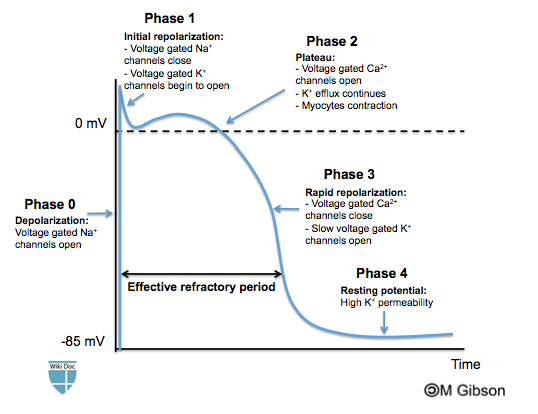WBR1016
Jump to navigation
Jump to search
| Author | [[PageAuthor::Rim Halaby, M.D. [1] (Reviewed by Serge Korjian)]] |
|---|---|
| Exam Type | ExamType::USMLE Step 1 |
| Main Category | MainCategory::Pharmacology |
| Sub Category | SubCategory::Cardiology |
| Prompt | [[Prompt::A 27-year-old man presents for his regular medical check-up following a recent visit to Cambodia. He reports severe malaria during his visit requiring intravenous treatment that led to severe headaches and tinnitus. Which of the following phases of the ventricular action potential is affected by the medication used to treat malaria in this patient? |
| Answer A | AnswerA::A |
| Answer A Explanation | [[AnswerAExp::A corresponds to phase 0 of the ventricular action potential. Phase 0 is characterized by a depolarization caused by the abrupt opening of the voltage gated sodium channel. Quinidine is an antiaarhythmic acting on the voltage gated sodium channels; therefore, affecting phase 0 of the ventricular action potential.]] |
| Answer B | AnswerB::B |
| Answer B Explanation | [[AnswerBExp::B corresponds to phase 1 of the ventricular action potential. Phase 1 is characterized by an early repolarization caused by the closure of the sodium channels and the opening of voltage gated potassium channels. Quinidine affects phase 0 of the ventricular action potential.]] |
| Answer C | AnswerC::C |
| Answer C Explanation | [[AnswerCExp::C corresponds to phase 2 of the ventricular action potential. Phase 2 is characterized by a plateau. The plateau results from the opening of the voltage gated calcium channels leading to an influx of calcium that balances the potassium efflux. Quinidine affects phase 0 of the ventricular action potential.]] |
| Answer D | AnswerD::D |
| Answer D Explanation | [[AnswerDExp::D corresponds to phase 3 of the ventricular action potential. Phase 3 is characterized by a rapid repolarization caused by the closure of the calcium channels and opening of the slow voltage gated potassium channel. Quinidine affects phase 0 of the ventricular action potential.]] |
| Answer E | AnswerE::E |
| Answer E Explanation | [[AnswerEExp::E corresponds to phase 4 of the ventricular action potential. Phase 4 is characterized by a resting potential which is caused by the high potassium permeability through the potassium channels. Quinidine affects phase 0 of the ventricular action potential.]] |
| Right Answer | RightAnswer::A |
| Explanation | [[Explanation::Intravenous quinidine is used for the treatment of severe complicated malaria. Cinchonism characterized by headaches and tinnitus is a side effect of quinidine. Quinidine is also an antiaarhythmic acting on the voltage gated sodium channels; therefore, affecting phase 0 of the ventricular action potential.
The ventricular action potential is composed of four phases:
Shown below is an image depicting the different phases of the ventricular action potential.
|
| Approved | Approved::Yes |
| Keyword | WBRKeyword::Quinidine, WBRKeyword::Cardiac action potential, WBRKeyword::Heart, WBRKeyword::Cardiology, WBRKeyword::Antiarrhythmic |
| Linked Question | Linked:: |
| Order in Linked Questions | LinkedOrder:: |

